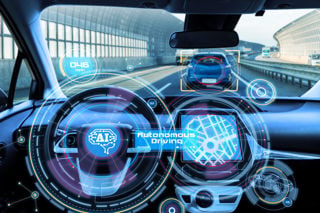The Government has confirmed it will legalise the use of “self-driving” driver assistance systems before the end of the year.
Under the new proposals, drivers of vehicles equipped with autonomous lane-keeping systems (ALKS) would be permitted to use them at speeds up to 37mph on motorways.
A number of vehicles are already equipped with adaptive cruise control and lane keeping systems that allow them to technically drive themselves in certain situations. But current legislation states that the driver must remain in control at all times.
If the new laws are approved, drivers would no longer have to keep their hands on the wheel or pay attention to the road ahead while the system was active.
Speed limitations mean the system could only be utilised in traffic jams, but would potentially enable drivers to perform activities like using their smartphone or read a newspaper. Drivers would be required to take control of the vehicle, if requested, within 10 seconds.
A new consultation has been launched today (April 28) to define how the system may be used.
Transport Minister Rachel Maclean said: “This is a major step for the safe use of self-driving vehicles in the UK, making future journeys greener, easier and more reliable while also helping the nation to build back better.
“But we must ensure that this exciting new tech is deployed safely, which is why we are consulting on what the rules to enable this should look like. In doing so, we can improve transport for all, securing the UK’s place as a global science superpower.”
The safety of ALKS has been questioned by organisations including The AA and Thatcham Research.
Edmund King, AA president, said: “Automated Lane Keeping systems should be classified as ‘Assisted Driving’ technology and is a world away from ‘self-driving’.
“Without doubt vehicle safety technology can save lives, but we shouldn’t be in race to take drivers’ hands off the wheel.
“There are still gaps in how this technology detects and stops if the vehicle is involved in a collision. There are still question marks over how drivers will be fully informed how these systems work. More needs to be done to rigorously test these systems before they are used on UK roads.”
The Government claims that the technology could improve road safety by reducing human error, which contributes to over 85% of accidents.
Matthew Avery, director of research at Thatcham Research, said: “Aside from the lack of technical capabilities, by calling ALKS automated our concern also is that the UK Government is contributing to the confusion and frequent misuse of assisted driving systems that have unfortunately already led to many tragic deaths.
“A widespread and effective ongoing communications campaign led by the automotive industry and supported by insurers and safety organisations is essential if we are going to address current and future misconceptions and misuse.”
Ian McIntosh, CEO of RED Driver Risk Management, added: “We were particularly concerned about the proposed line for the Highway Code in the Department for Transport consultation on Automatic Lane Keeping Systems which stated while an automated vehicle is driving itself, you are not responsible for how it drives, and you do not need to pay attention to the road.
“Autonomous driving technology can help make vehicles safer, but to suggest that the driver is not ultimately responsible for the operation of a car or van is utterly wrong - and potentially dangerous. The driver must always be fully accountable, and the fact that even at the consultation stage removing this basic concept has been mooted, suggests the Government has got too far ahead of itself, the technology and the fleet industry on this.
“It sends the wrong message to drivers, sows confusion about what technology can do, and demonstrates a lack of understanding of the fleet sector’s needs in terms of risk management and duty of care.
“There are already so many unanswered questions about how autonomous vehicles will operate in the real world, such as who is liable in the event of an accident, and so at this early stage to be thinking of taking the driver out of the equation makes the issue even more challenging. Who is going to be held responsible and accountable if the person behind the wheel isn’t?”





















Login to comment
Comments
No comments have been made yet.